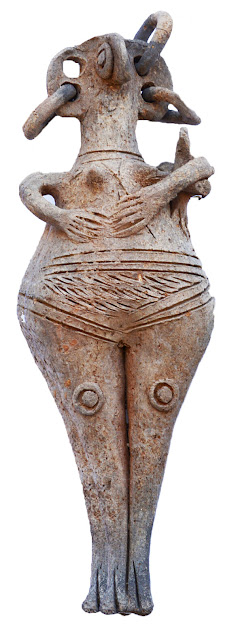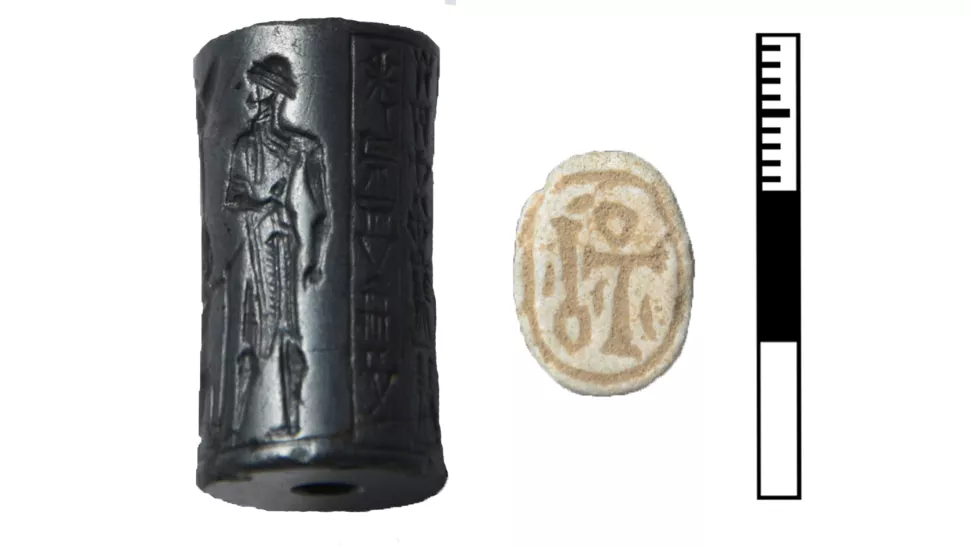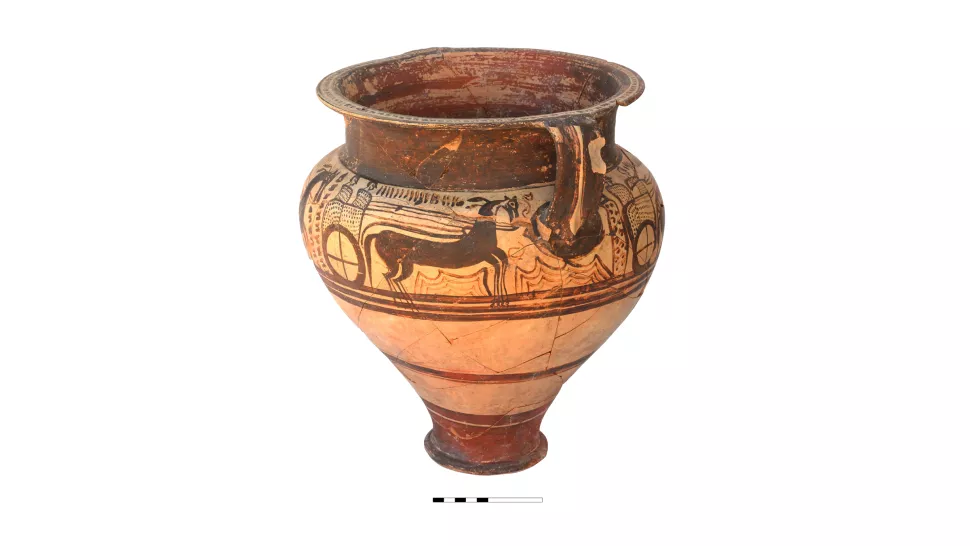TWH- The ancient Mediterranean contains many central well-known regions of ancient pagan practice. These spots include Crete, Egypt, mainland Greece, Rome, and parts of the Fertile Crescent. Many Pagans are familiar with these areas but often less familiar with their margins.
Archaeologists have recently reported findings from three of these less central areas. They have found grave goods in Scythia and Cyprus. When people bury a valuable object like gold or a weapon, they remove it from circulation. It represents a kind of sacrifice. The meaning of that sacrifice depends on local beliefs and may have varied among cultures. Archaeologists also found a Roman griffin-like statuette in the United Arab Emirates.
Silver plate from Scythia
Russian archaeologists excavated a Scythian grave along the Don River, just north of eastern Ukraine. They reported about finding grave goods and skeletal remain. Among those grave goods, was a silver plate with images of a goddess and magical creatures
In the center of that plate, an image of the Scythian fertility goddess, Argimpasa, stares back. Like the more famous Minoan goddess, she bares her breasts. She wears a crown with horns. On both sides, winged eagle-headed griffins surround Argimpasa.
According to the Russian archaeologists, the images on the plate mixed Anatolian and Greek traditions. In this region, this mixture of cultures occurred often. They linked Agrimpasa with Cybele.
They found this plate in a necropolis with 19 burial mounds. These mounds occur in two parallel lines from west to east. In that necropolis, archaeologists excavated the largest mound (barrow 7). It had a height of 4.3 feet (1.3 meters) and a diameter of 131.2 feet (40 meters). This mound contained several graves.
Near the center of the mound, its largest tomb measured 24.6 by 16.4 feet (7.5 by 5 meters). Originally, 17 large oak pillars held up oak half-beams. That roof has since collapsed. They dated its largest wooden tomb to the period from 301 to 400 C.E.

A silver plate was found in the Scythian Tomb. The plate depicts the goddess Argimpasa along with griffons and other creatures. (Photo credit: Courtesy Russian Academy of Sciences)
In the grave’s southeast corner, archaeologists found fragments of horse harnesses. In this area, they found Scythian pendants made of bone. They also found six “cheek-piece bronze plates in the shape of wolves, with grin jaws two on each harness.” Someone had left in the tomb a young bear’s cut jaw. Archaeologists linked this jaw to the bear cult of the Scythians of the middle Don region.
In the northeast part of the grave, they found the silver plate. Someone had nailed it with silver nails to what was once a wooden base. It measured 13.7 inches (34.7 cm) with a width of 2.9 inches (7.5 cm).
That tomb has one known occupant. Scientists have classified the skeletal remains as those of a male between the ages of 40 and 49. Nearby, lay an iron knife, the rib of a horse, a spearhead, and three dart heads. Scientists estimate the length of the spear to be around 10.5 feet (3.2 meters) and that of the dart to be 7.2 feet (2.2 meters). Archaeologists think that the horse rib indicated a ceremonial food.
Roman griffin-like statuette found in the United Arab Emirates
ArchaeologyNewsNetwork reported that archaeologists found a bronze statuette of a griffin-like creature in the Sharjah region of the United Arab Emirates. That statuette has eagle wings, a lion’s head, and a huge bird’s foot with claws. Note this definition differs from the traditional definition of a griffin. A griffin has the head of an eagle.
Archaeologist, Dr. Sabah Aboud Jassim, Director General of the Sharjah Archaeology Authority, said the artifact formed part of a censer. With two other statuettes, it formed the circular base of a censer. On top of those three statuettes, a large bowl would have held the burning incense.

The bronze statuette of a griffin. Photo Credit: Sharjah Archaeology Authority
The artifact dates to the period from 1 to 100 C.E. Jassim linked the statuette to Roman trading networks. That linkage suggests that people in different cultures along those trade networks were familiar with visual representations of griffins and griffin-like creatures.
Late Bronze Age Cypriot burials link three continents
ArcheaologyNewsNetork reported that German archeologists found 155 skeletal remains and 500 artifacts in two tombs from Cyprus. Scientists have dated these tombs to around 1350 B.C.E.
The tombs have the form of underground chambers. Besides grave goods, they contained many skeletal remains as well as grave goods. The bones and grave goods were piled up, lasagna-like, in layers, one on top of another. Scientists interpreted this layering to indicate use over several generations.
Archaeologists believe that this burial site served the local elite. For example, someone had adorned a five-year-old child with a necklace, earrings, and a tiara. All were made of gold.
Those grave goods included a gold lotus flower pendant, inlaid with gemstones. Nefertiti wore similar jewelry to those found in these graves. These similarities allowed scientists to date those grave goods to the time of Nefertiti and Akhenaten. They reigned in Egypt around 1350 B.C.E., the late Bronze Age.
One ceramic artifact had the shape of a hollow bull. It had two openings. One could fill it with a liquid and drink from it. They also found figurines of goddesses with bird faces.
Another find was a seal in the shape of a cylinder, made from reddish hematite. That seal has a cuneiform inscription, indicating a Mesopotamian origin. Scientists translated the cuneiform inscription. It had three lines with one name on each line. On one line, someone had inscribed the name of the Mesopotamian god, Amurru. On the second and third lines, the names of two historical kings, a father and son, had been inscribed. They had reigned sometime between 1801 and 1700 B.C.E. Somehow, that cylinder had traveled 400 years and over 621.4 miles (1,000 km) to end up in a tomb in Cyprus.
Among the grave goods, they also found items made of gold, silver, bronze, and ivory. Archaeologists also found in these tombs, red carnelian gems from India, blue lapis lazuli from Afghanistan, amber from the Baltic, scarabs from Egypt, and fish bones from the Nile Valley. These trading networks of the late Bronze Age connected a larger area than Alexander conquered. They also predated his conquests by a millennium.
The Wild Hunt is not responsible for links to external content.
To join a conversation on this post:
Visit our The Wild Hunt subreddit! Point your favorite browser to https://www.reddit.com/r/The_Wild_Hunt_News/, then click “JOIN”. Make sure to click the bell, too, to be notified of new articles posted to our subreddit.


